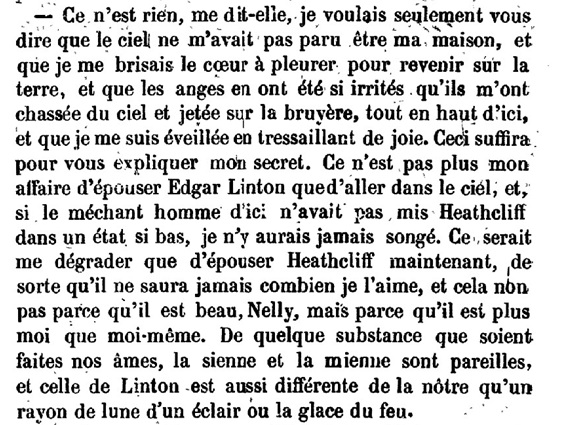Charlotte Brontë: a passion for writing
After the mysterious atmosphere of gothic novels and the sentimental novels of Jane Austen, let us discover the passionate world of Charlotte Brontë and her Sisters!
Portrait oh Charlotte Brontë by George Richmond, 1850 © National Portrait Gallery, London
It is under the pen name of Currer Bell that Charlotte Brontë made her entry into the world of literature in the Victorian era, revolutionising conventions with a great liberty of tone.
Here is how Jehanne Foucque described the famous English writer Charlotte Brontë in 1899, according to the memories of her best friend, Elizabeth Gaskell, the author of Mary Barton (1848).

Jehanne Foucquet, Charlotte Bronté. Paris : Fischbacher, 1899. p.14
From the early age of 9, Charlotte, her sisters Emily and Anne, and their brother Branwell, wrote stories that took place in the imaginary kingdoms of Gondal and Glasstown, which they located in Africa. Inventing heroes and heroines inspired by the writings of Byron and Walter Scott or by accounts of the Napoleonic wars they read, the siblings staged dramas, poems and short plays, and went as far as publishing their works and magazines themselves in miniature size. Charlotte thus practised writing for many years before publishing a collection of poems, together with her two sisters under masculine noms de plume: Poems by Currer, Ellis and Acton Bell (1846). As their brother sinks into alcoholism and ruins his own plans in 1847, the three sisters each published a novel under mysterious names. Anne published Agnes Grey under the pen name of Acton Bell. Emily published Wuthering Heights under the pen name of Ellis Bell, while Charlotte published Jane Eyre under the pen name of Currer Bell – which lead to great confusion about their respective identities:

La revue hebdomadaire, 17 juillet 1926, n°29
Jane Eyre is Charlotte’s most famous novel. It is about the life of Jane, a young orphan, in a very patriarchal society. The heroine’s strength of character surprised the critics, who were not used to seeing young women stand up to their employers. It has to be said that Jane, first rejected by her aunt, and then abused at Lowood school, developed a very determined personality. As the governess of Mr Rochester’s ward Adele, Jane hears a mysterious laugh soon upon arrival at the imposing mansion of Thornfield, which has something of the gothic novels, with their ghosts and mysterious lodgings:

Charlotte Brontë. Jeanne Eyre, ou les Mémoires d'une institutrice. Paris : Giraud, 1854. p. 127

Affiche de la pièce Jane Eyre, Dicks' standard plays © The New York public library
The reader is hooked by the evolution of the relationship between Jane and Mr Rochester, conducive to conversations which are often passionate, where the young governess does not hesitate to express her opinions with a liberty of tone unbefitting her social station. This is what we can observe in this audio excerpt, during a party given at Thornfield:
Charlotte’s first novel The Professor (1857) was refused many times by publishing houses due to its monotonous tonality. It nevertheless encompassed a minute description of Belgium, where Charlotte, accompanied by her sister Emily, had stayed to perfect her French language skills, intending to open a school upon her return to Haworth. The teaching profession is described very realistically in the novel:

Charlotte Brontë. Le professeur. Paris : Hachette, 1858. p. 148
Embedded in the social reality of Victorian England, the novel Shirley (1849) depicted the industrial depression around 1812 in Yorkshire, with the portrait of a young heiress, Shirley Keeldar, greatly inspired by Emily Brontë, the author’s sister:

Charlotte Brontë. Shirley. Paris : Hachette, 1859. p. 177
With the novel Wuthering Heights, translated into French in 1892 under the title L’Amant, Charlotte’s sister Emily also went against the grain of Victorian good taste by staging the violence of passion and the revenge of Heathcliff, a masculine hero constructed outside the boundaries of morality:

Théodore de Wyzewa in Emily Brontë. Un amant. Paris : Perrin, 1892. p. VIII
In this dark novel, with the rough and wild landscapes of the Yorkshire moors as sole backdrop, the passion between Catherine and Heathcliff, who was taken in by her father when he was a boy, keeps growing and creating dramatic events around them. In a moment of contemplation, Catherine confesses her love for Heathcliff to her maid Nelly. It is an attachment far from the accepted conventions, a passion which irredeemably links her to someone she considers to be her other self:

Emily Brontë. Un amant. Paris : Perrin, 1892. p. 92
Less passionate, Charlotte Brontë’s last novel, Villette (1853), retraced the peregrinations of Lucy Snowe, in a city inspired by Brussels. It questioned the feminine condition in a world where women were barely getting access to education. After the death of both her sisters Emily and Anne, as well as that of her brother Branwell, all victims of tuberculosis, Charlotte married her father’s vicar, Arthur Bell Nicholls in 1854, and started working on a new novel. Having become a renowned writer and after having revealed her real identity, she died in 1855 at the age of 38. Numerous theatrical and cinematographic adaptations enabled the character of Jane Eyre to become a new feminine archetype, foreshadowing feminist struggles to come.

Atelier de Nadar, Jane Eyre, artiste dramatique, 1900, © département des Estampes et de la photographie
Further reading:
Manuscript of Jane Eyre kept at the British Library
Image library of the Brontë Society
Charlotte Brontë Exhibition, Septembre 30, 2016 – January 2, 2017, New York, The Morgan library
And read the previous blog posts in the series « English Women Writers »
Isabelle Le Pape
(translated from French by Claire Carolan)




Ajouter un commentaire